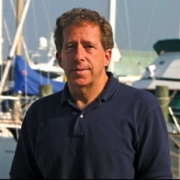Knauss legislative fellowships in Congress help build careers — and they're fun and educational. See our video and fact sheet for details.
Maryland Sea Grant’s Program Leader for Extension to Step Down

Lipton named top fisheries economist at national agency
Douglas Lipton, director of Maryland Sea Grant’s Extension team, will step down from his position this June to pursue a new opportunity. He will join the National Oceanic and Atmospheric Administration (NOAA) as the senior research economist at the agency’s National Marine Fisheries Service.
He will be missed in Maryland and beyond. “Doug is an icon in the Bay, both as a highly respected and valued economist and as Maryland Sea Grant’s Extension program leader,” said Troy Hartley, who directs Virginia’s Sea Grant program.
Lipton has been with Maryland Sea Grant since 1988, first as a fisheries economics specialist and, since 1993, as the head of the Extension program. The program’s agents and specialists reach out to government agencies and communities across Maryland to promote the restoration of the Chesapeake Bay and the well-being of local communities -- whether it’s by helping to improve the water quality of local streams or by aiding efforts to restore native oysters to the estuary. Under Lipton’s leadership, Sea Grant Extension grew from six staff members to the 13 on board today. Most of the newcomers work on watershed restoration and the local effects of climate change. In all, the staff members hail from diverse fields and include experts in education, food safety, and business.
Now a fisheries economist, Lipton first got his start as a biologist, catching, weighing, and analyzing river herring from Virginia and other fish up and down the Atlantic Coast. But he had always been interested in what he calls the “human element” of fisheries. Or how healthy fisheries can impact local economies and vice versa. Today, much of his research focuses on evaluating the economic benefits of conserving fish populations and restoring the Bay’s water quality.
In a project supported by Sea Grant, for instance, Lipton surveyed recreational boaters across Maryland to see how they add to the state’s economy. He found that boaters generate an average of $1 billion per year for the region. But many boaters might also abandon their hobby if the Bay’s water quality becomes too degraded, Lipton argues.
In a second project, Lipton sought to evaluate how U.S. immigration policies have impacted local seafood processors. Many of these businesses, which have a long history in the state, rely on immigrant workers who come to Maryland on guest worker visas to do their picking and canning. But those same visas can be difficult to obtain. Lipton showed, among other things, that employing guest workers actually increases job growth in the state -- to the tune of 2.5 jobs added for each worker brought in on a visa.
More recently, Lipton helped Maryland’s Department of Natural Resources to launch an innovative “buy back” program for commercial blue crab fishing licenses. By 2011, the state had purchased more than 700 licenses back from Marylanders who hadn’t fished for crabs in years. In theory, those buy backs could limit the number of fishermen returning to the water now that the Bay’s crab population has begun to recover from a lengthy decline; this reduction in fishing pressure could help the population from declining again. (To learn more about this program, check out this 2012 feature article "The Value of Crabbing" in Chesapeake Quarterly, Maryland Sea Grant's magazine.)
Throughout his career, Lipton has been a strong supporter of using results from social science research to inform decisions affecting the Bay’s environment and surrounding human population. That wasn’t always easy. He served for years on the Scientific and Technological Advisory Committee of the Chesapeake Bay Program, the partnership in charge of the Bay’s cleanup. And for a lot of that time, he was one of the very few economists in the group, providing scientific advice to that partnership. More recently, he said, “I’ve sat in meetings where I hear people that would never have brought up the terms ‘economics’ or ‘socioeconomics’ saying, ‘This is what we need to focus on.’ ” After all, he noted, the Bay’s restoration is a human problem and opportunity.
Lipton said that it will be hard to leave Sea Grant, since it’s been so integral to his career. But he’s looking forward to continuing to study Bay fisheries and issues that could affect them in his new position. “Sea Grant is in my blood,” he said.
“Doug has made a tremendous contribution to our understanding of fisheries economics in the Chesapeake Bay region and at the national level,” said Fredrika Moser, director of Maryland Sea Grant. “NOAA could not have chosen a more talented and thoughtful scientist for their number-one fisheries economist position. He will be sorely missed from the helm of the Maryland Sea Grant Extension program, where his exceptional vision and leadership skills succeeded in building a highly regarded extension team. We look forward to continuing our collaborations with Doug from his new position at NOAA and wish him every success.”
-- Daniel Strain






